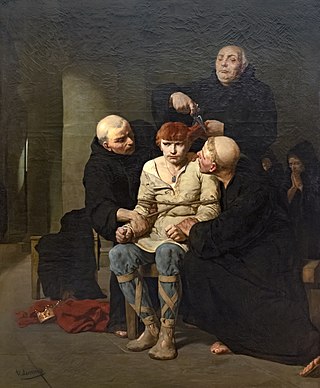
Year 737 (DCCXXXVII) was a common year starting on Tuesday of the Julian calendar. The denomination 737 for this year has been used since the early medieval period, when the Anno Domini calendar era became the prevalent method in Europe for naming.

Pelagius was a Hispano-Visigoth nobleman who founded the Kingdom of Asturias in 718. Pelagius is credited with initiating the Reconquista, the Christian reconquest of the Iberian Peninsula from the Moors, and establishing the Asturian monarchy, making him the forefather of all the future Iberian monarchies, including the Kings of Castile, the Kings of León, and the Kings of Portugal.

The Battle of Covadonga took place in 718 or 722 between the army of Pelagius the Visigoth and the army of the Umayyad Caliphate. Fought near Covadonga, in the Picos de Europa, it resulted in a victory for the forces of Pelagius. It is traditionally regarded as the foundational event of the Kingdom of Asturias and thus the initial point of the Christian Reconquista ("reconquest") of Spain after the Umayyad conquest of 711.

Asturias, officially the Principality of Asturias, is an autonomous community in northwest Spain.
Alfonso I of Asturias, called the Catholic, was the third king of Asturias, reigning from 739 to his death in 757. His reign saw an extension of the Christian domain of Asturias, reconquering Galicia and León.
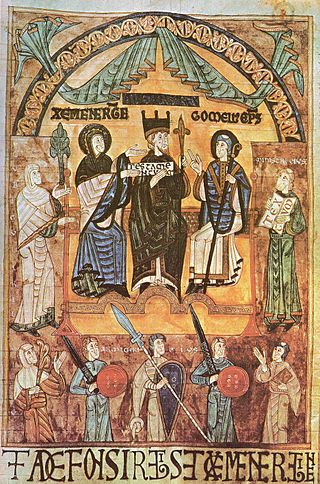
Alfonso III, called the Great, was the king of León, Galicia and Asturias from 866 until his death. He was the son and successor of Ordoño I. In later sources he is the earliest to be called "Emperor of Spain." He was also titled "Prince of all Galicia".
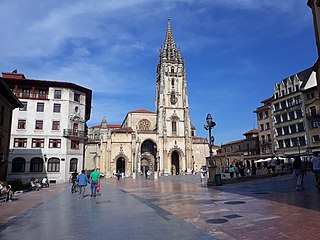
Oviedo or Uviéu is the capital city of the Principality of Asturias in northern Spain and the administrative and commercial centre of the region. It is also the name of the municipality that contains the city. Oviedo is located approximately 24 km (15 mi) southwest of Gijón and 23 km (14 mi) southeast of Avilés, both of which lie on the shoreline of the Bay of Biscay. Oviedo's proximity to the ocean of less than 30 kilometres (19 mi) in combination with its elevated position with areas of the city more than 300 metres above sea level causes the city to have a maritime climate, in spite of its not being located on the shoreline itself.

Aurelius was the King of Asturias from 768 to his death.

Ramiro I was king of Asturias from 842 until his death in 850. Son of King Bermudo I, he became king following a succession struggle after his predecessor, Alfonso II, died without children. During his turbulent reign, he fended off attacks from both Vikings and Moors. Architecturally, his recreational palace Santa María del Naranco and other buildings used the ramirense style that prefigured Romanesque architecture. He was a contemporary of Abd ar-Rahman II, Umayyad Emir of Córdoba.

Cangas de Onís is a municipality in the eastern part of the province and autonomous community of Asturias in the northwest of Spain. The capital of the municipality is also Cangas de Onís.

The Asturian or Astur-Leonese dynasty, known in Arabic as the Banī Adhfūnsh, was the ruling family of the kingdom of Asturias and León from 739 until 1037. Under their rule, the Astur-Leonese kingdom went from a small mountain enclave to one of the dominant powers in Hispania.

Pre-Romanesque architecture in Asturias is framed between the years 711 and 910, the period of the creation and expansion of the kingdom of Asturias.

The Victory Cross is an early 10th century Asturian crux gemmata or jewelled cross, given by King Alfonso III of Asturias, who reigned from 866 to 910, to the Cathedral of San Salvador of Oviedo. It was made in 908 in the Castle of Gauzón . At the core is an oakwood cross, in legend identified with a cross carried by King Pelagius of Asturias at the Battle of Covadonga.

Santa Cruz de Cangas de Onís is a small Roman Catholic chapel in Cangas de Onís, the first capital of the Kingdom of Asturias, in what is now northern Spain. It was founded on an artificial mound by Favila, second king of Asturias, and his queen, Froiliuba. It was begun in 737 and consecrated that same year on 27 October according to its original foundation stone, which has been called the first literary monument of the Reconquista.

Santa Cruz is a Pre-Romanesque Roman Catholic church located in Cangas de Onís, in Asturias, Spain.
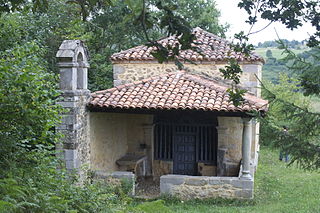
Capilla de Santa Eugenia de Sobrecueva is a church in Asturias, Spain.

The Santa Cueva de Nuestra Señora de Covadonga is a Catholic sanctuary located in Asturias, northern Spain. It is a cave in the Picos de Europa mountains, which gives its name to the parish of Covadonga in the municipality of Cangas de Onís. The name refers to the sanctuary, dedicated to the Virgin of Covadonga, where the first battle of the Spanish Reconquest took place in 718.
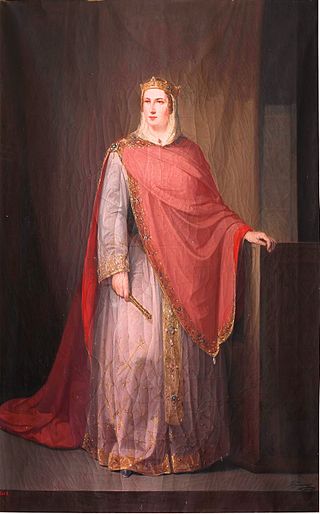
Ermesinda alternatively Ormisenda, Ermisenda, Ermesinde, Ermessenda) was queen consort of the Kingdom of Asturias, wife of King Alfonso I of Asturias. She was the daughter of King Pelagius of Asturias and his queen, Gaudiosa.
The Royal Collegiate church of San Fernando is a collegiate church located in the parish of Covadonga, Cangas de Onís, Asturias, Spain. It was declared Bien de Interés Cultural in 1884.

















